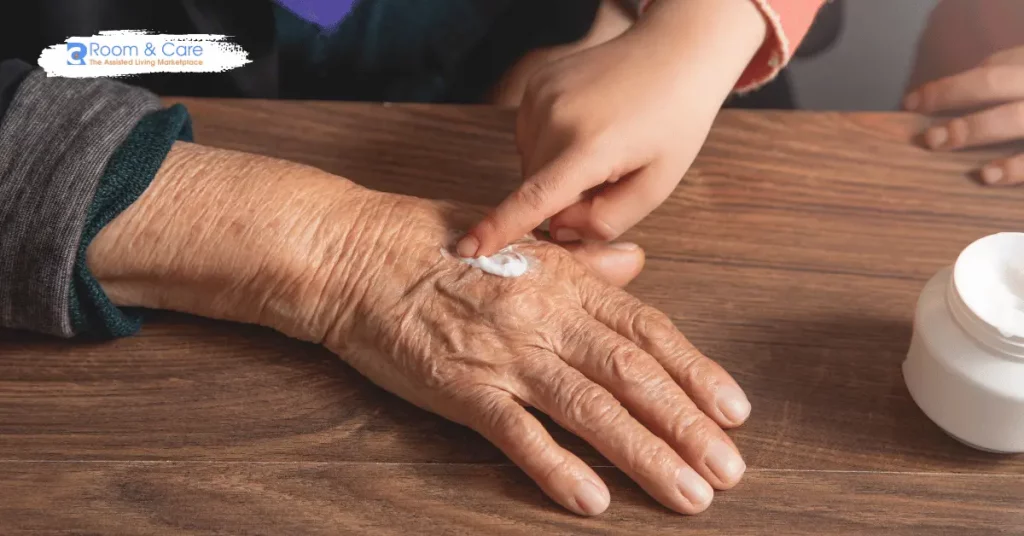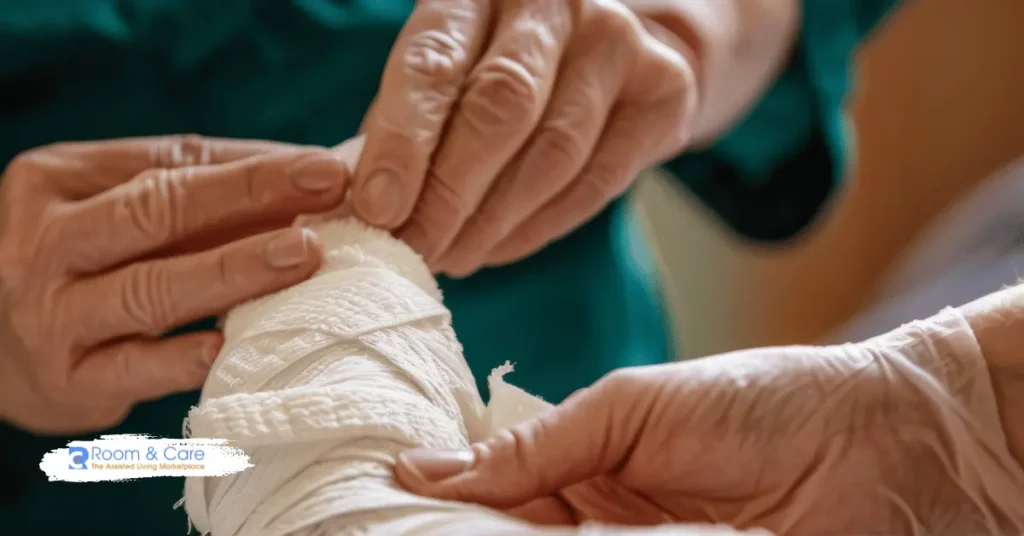

Elder wound care is a crucial aspect of caring for seniors, particularly for those living in assisted living facilities, adult family homes, nursing homes, or receiving care at home. As individuals age, their skin becomes more fragile, making them more vulnerable to injuries and slower healing processes. Whether your loved one is living independently or in a care facility, ensuring proper wound care is essential for their health, dignity, and overall well-being.
In this guide, we’ll explore everything you need to know about elder wound care, from understanding the different types of wounds common in seniors to practical tips on managing and preventing wounds. We’ll also discuss how senior living communities can provide expert care and create an environment conducive to healing. Whether you’re a family caregiver or seeking the best facility for your loved one, this guide will help you make informed decisions and navigate the complexities of wound care.
As people age, their skin becomes thinner, less elastic, and more susceptible to injury. Additionally, many seniors suffer from conditions like diabetes, poor circulation, or immobility, which can increase the risk of wounds and make them more difficult to heal. Without proper care, even minor wounds can lead to serious complications, such as infections, pressure ulcers, or long-term hospitalization.
In senior living communities, wound care is often managed by trained staff who understand the nuances of caring for fragile skin. These facilities focus on prevention, early detection, and effective treatment to ensure that wounds do not worsen over time.
For family caregivers, understanding the basics of wound care is equally important. Whether your loved one is at home or in a senior care facility, timely intervention and proper care techniques can significantly improve outcomes.
Before we dive into wound care techniques, it’s essential to understand the most common types of wounds that affect seniors:
Pressure ulcers, commonly known as bedsores, occur when continuous pressure is placed on the skin for long periods, cutting off blood flow. This can lead to skin breakdown and the formation of ulcers. Pressure ulcers are common among seniors who are bedridden or have limited mobility, making them a frequent concern in nursing homes and assisted living facilities.
For seniors with diabetes, wound care becomes even more complex. Diabetic ulcers usually develop on the feet due to nerve damage and poor circulation. These wounds are slow to heal and require meticulous care to prevent infection or, in severe cases, amputation.
Venous leg ulcers occur when veins in the legs are unable to circulate blood properly, leading to fluid buildup and tissue damage. These ulcers are common in seniors with poor circulation and may take months to heal if not managed properly.
As skin becomes thinner with age, even minor trauma, such as bumping into furniture or handling, can cause skin tears. These injuries may seem minor but can escalate quickly if they’re not treated carefully.
Wound healing in seniors is more complicated than in younger individuals due to several factors, including:
When managing wound care for seniors, especially in the context of senior living communities, there are several key considerations:
The sooner a wound is detected, the better the chances of preventing complications. Caregivers in nursing homes or adult family homes are trained to conduct routine skin checks to catch early signs of pressure ulcers, skin tears, or other wounds. If you’re caring for a loved one at home, make it a habit to inspect their skin regularly, especially in areas prone to pressure, such as heels, hips, and lower back.
Proper wound cleaning is essential to prevent infection. This involves using sterile water or saline to clean the wound and applying a fresh, sterile dressing to protect the area. Dressings should be changed regularly, based on the type of wound and the healthcare provider’s recommendations.
Nutrition plays a vital role in wound healing. Seniors need a well-balanced diet rich in protein, vitamins A and C, and zinc to support tissue repair. For those in assisted living facilities or adult family homes, caregivers often work closely with nutritionists to ensure that residents receive meals that promote wound healing.
In cases where malnutrition is a concern, supplements may be necessary. Ensuring proper hydration is equally important, as dehydration can impair the body’s ability to heal.
Preventing pressure ulcers requires frequent repositioning of seniors with limited mobility. For example, bedridden individuals in nursing homes are often repositioned every two hours to relieve pressure on vulnerable areas. Specialized mattresses, cushions, and other pressure-relieving devices can also help distribute body weight more evenly, reducing the risk of pressure ulcers.
Preventing infections is a top priority in wound care, especially for seniors. Caregivers in senior living communities are trained in infection control practices, such as hand hygiene, proper wound dressing techniques, and monitoring for signs of infection. For family caregivers, it’s essential to follow these protocols at home, using sterile materials and keeping the wound clean and dry.

When it comes to wound care, senior living communities like adult family homes, nursing homes, and assisted living facilities offer a range of specialized services to ensure residents receive the best possible care. Here’s how wound care is managed across different types of facilities:
Adult family homes provide a smaller, more personalized care environment, often catering to a few residents at a time. Caregivers in these homes offer one-on-one attention, closely monitoring each resident’s condition and tailoring wound care treatments accordingly. This individualized approach is particularly beneficial for seniors with chronic wounds or those recovering from surgery.
Assisted living facilities are designed to promote independence while offering medical support when needed. Many of these facilities have licensed nurses on staff who can assist with wound care, dressing changes, and monitoring healing progress. In more severe cases, assisted living facilities may collaborate with external wound care specialists or clinics to ensure residents receive advanced treatments.
Nursing homes provide a higher level of medical care compared to assisted living or adult family homes. Wound care in nursing homes is typically overseen by registered nurses or healthcare providers with specialized training in wound management. For seniors with complex wounds, such as diabetic ulcers or severe pressure ulcers, nursing homes offer the necessary medical equipment and expertise to manage these conditions effectively.
For seniors with dementia or Alzheimer’s disease, wound care can be more challenging due to cognitive impairments. In memory care units, staff are trained to handle these challenges, ensuring wounds are treated even if the senior cannot communicate their discomfort. These facilities often adopt a proactive approach, closely monitoring residents for any signs of injury or skin breakdown.
If you’re caring for an elderly loved one at home, here are some practical wound care tips to help ensure their comfort and safety:
Regular skin inspections are crucial for detecting early signs of wounds or pressure ulcers. Pay close attention to areas where the skin is thinner or more prone to pressure, such as the heels, elbows, and lower back.
When changing dressings or cleaning wounds, ensure that you’re working in a clean environment. Use sterile gloves and materials, and always wash your hands before and after providing care.
Different types of wounds require different dressings. For example, some wounds need moisture to promote healing, while others require dry dressings. Consult with a healthcare provider or wound care specialist to ensure you’re using the most appropriate materials for your loved one’s specific wound.
Encourage your loved one to move or change positions regularly to prevent pressure ulcers. Even small movements, such as shifting in bed or doing light stretches, can improve circulation and reduce the risk of skin breakdown.
If your loved one’s wound is not healing, appears infected, or is causing significant pain, don’t hesitate to seek help from a healthcare professional. In some cases, home health services may be available to provide wound care assistance.

A: Wound healing times vary depending on the type of wound, the senior’s overall health, and whether they have underlying conditions like diabetes or poor circulation. Minor wounds may heal within a few weeks, while more complex wounds, such as diabetic ulcers or pressure sores, can take months.
A: Signs of infection include increased redness, swelling, warmth around the
wound, pus or drainage, foul odor, and increased pain. If you notice any of these signs, it’s essential to seek medical attention immediately. Infections can worsen quickly in seniors, so early detection and treatment are crucial to preventing complications.
A: Yes, pressure ulcers can often be prevented with proper care. Regular repositioning, using pressure-relieving devices like specialized cushions or mattresses, and ensuring that seniors maintain good hygiene and nutrition are all effective ways to prevent pressure ulcers. In nursing homes or assisted living facilities, caregivers are trained to regularly check for pressure sores and take action to alleviate pressure on vulnerable areas.
A: Family caregivers can manage wound care at home by keeping the wound clean and dry, regularly changing dressings, and following healthcare provider instructions. Ensuring proper nutrition, hydration, and regular movement is also key. If the wound doesn’t heal or shows signs of infection, it’s important to contact a healthcare professional. In some cases, a home health nurse may be necessary to assist with wound care.
A: Seniors with chronic wounds that require constant care may benefit from living in assisted living facilities or nursing homes, where trained staff can monitor and manage wound care effectively. Nursing homes, in particular, offer medical staff who specialize in complex wound care, while assisted living facilities often provide support for seniors with less severe conditions. The choice between the two depends on the level of care needed and the senior’s overall health and mobility.
Elder wound care is a critical component of maintaining the health and well-being of seniors, especially those in senior living communities like adult family homes, assisted living facilities, or nursing homes. Whether you’re a family caregiver or considering professional care, understanding how to manage and prevent wounds can significantly improve your loved one’s quality of life.
For families seeking the best care options for their loved ones, Room and Care is here to help. Our platform connects you directly to a variety of senior living facilities, including assisted living, adult family homes, memory care, and nursing homes, without any referral fees or middlemen. This ensures you get the best care for your loved one at lower costs. Explore our resources today and find the right care facility that meets your needs.
Effective wound care doesn’t have to be overwhelming. With the right knowledge and support, you can help your loved ones heal faster and live more comfortably.